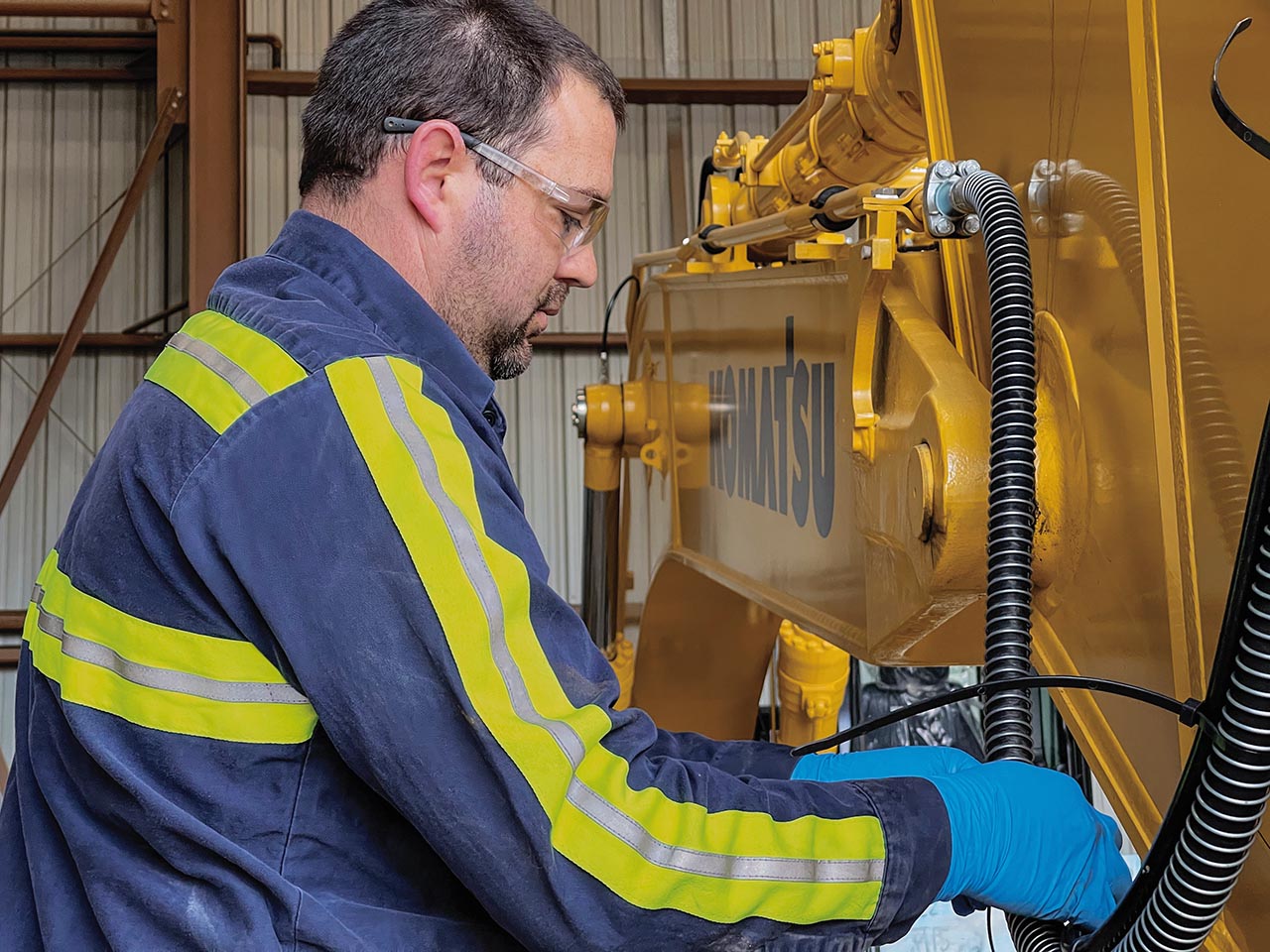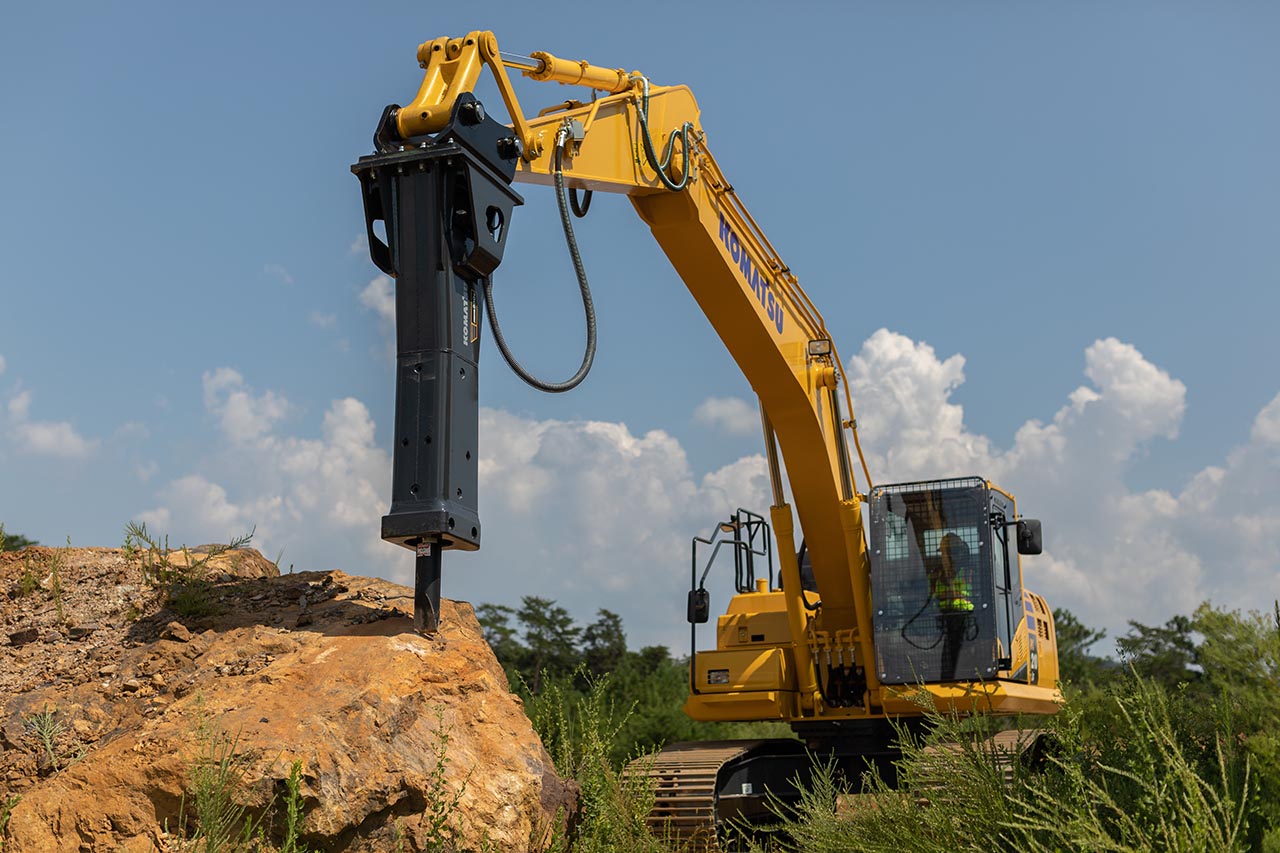4 min read
From crisis to strength: How Komatsu is reinventing its supply chain
- Operational efficiency,Blog
8 min read

Breakers play many roles on today’s construction and quarry sites—everything from demo work to road building. This valuable tool handles a variety of jobs by allowing you to break up hard materials for excavation.
“In areas where no drilling or blasting is allowed, there really is no other choice than a breaker,” said Greg Clinton, attachment product support manager, Komatsu. “Even in those areas where that’s not an issue or rocky soils are no problem, a breaker increases versatility and opens up new opportunities to increase your services.”
It's important to ask several questions before deciding which breaker is best for your needs. Clinton emphasized many factors go into choosing the right breaker.
There are criteria that have to be taken into account, starting with application,” Clinton said. “The tool for breaking up hard rock may be significantly different than one used for demolition of a road or building. Secondly, you have to consider the size of the carrier that you will mount the breaker on and determine what its capabilities are, how much it can lift, and how much flow it has. Finally, determine breaker size and match it to the machine for optimum performance.”
Installation options
If you are purchasing a new excavator and you think that you will use it with a breaker, consider having the machine set up at the factory with the necessary plumbing to run the attachment. If you are adding a breaker later, Clinton recommends having distributor/dealer technicians perform the work. He said that in most instances, it takes about 40 hours for installation.
If you put the plumbing kit on afterward, it's best to have skilled professionals who have the know-how to set up the carrier with the proper flows and pressures using a flow meter, and make sure the lines are large enough to handle them, said Clinton. Once they do that, they can remove the flow meter and install the breaker, identifying supply and return ports and attaching the applicable hoses.
Prior to operating the breaker, they will ensure grease is getting to the bushings. This eliminates speculation about whether the tool will work to its maximum potential. The distributor will provide documentation so, if there ever is an issue, there is a record of the install and how it was performed. That could be valuable in a warranty situation.
Clinton also advocates for quick couplers. They make the task of changing attachments easier because the mounting caps are ready to go.
It's easier than getting out of the machine to pound out pins to swap out attachments, he said. From the cab you can reach with the arm, grab the breaker with the coupler, pick it up and go to work. It's faster, simpler and safer.
Proper use affects working life
Using breakers correctly is essential to their longevity. They should only be used for their intended purposes and never to lift or pry. Always position a breaker perpendicular to the materials and warm up the equipment. Never use improperly worn tools that could easily break.
 Breakers can be valuable long-term assets if properly sized, used, installed and maintained. “If you do that, you can help increase profitability and your return on investment,” said Greg Clinton, product service manager, Komatsu.
Breakers can be valuable long-term assets if properly sized, used, installed and maintained. “If you do that, you can help increase profitability and your return on investment,” said Greg Clinton, product service manager, Komatsu.
Avoid blank firing at all times. This happens when a breaker is operating, and the tool is not preloaded against the piston or extended out of the chuck housing. A distinct metallic ringing will indicate blank firing. To prevent this, stop the breaker operation and reposition with good down pressure on the material you’re attempting to break.
“You should not let the breaker hit on one spot for more than 15 seconds, said Clinton. “Doing so causes heat buildup that results in loss of tool strength and wear resistance. It can also create dust between the impact face of the tool and the material you’re trying to break. That dust will absorb the impact force and weaken the effectiveness of each strike. You should pull up and reposition.
Additionally, you should not allow carrier cylinders to reach the end of their stroke during breaker operations. Never immerse the breaker in water or mud to any depth unless proper pressurization is in place.
Be vigilant about greasing
Operators or service personnel should keep the lube station and/or tubes from running dry and not let air into the lube systems. Using the proper amount of high-quality grease and putting it on correctly will reduce friction wear on the tool and the bushings.
An industry standard is to lubricate every two hours. You should also watch for seepage as grease runs down the tool tip; if it stops, the tool must be regreased immediately.
Breaker tools become extremely hot, so the grease you use should be rated to work at a minimum of 500 degrees Fahrenheit. Use a high-quality grease with, at minimum, a No. 2 lithium base containing 3% molybdenum. This chemical element is crucial because it helps the grease stick to the tool and not run off.
A lubrication system set to automatically grease during operation can help ensure the breaker remains greased. When purging the lube system, a hand grease pump is best. Pump grease into the grease line until a steady stream appears inside the hammer’s upper and lower bushing lube holes. Remove the handpump and reattach the grease hose to the breaker lube line.
Consistent inspections can prevent issues
Inspections are an essential part of keeping your breaker in proper working order. A daily walkaround performed before operation and periodically throughout the day should be part of any operator’s routine.
“Check for leaks, any developed cracks or loose hardware and check that the lube station has grease in it, said Clinton. “It’s just a visual inspection that requires no tools.
Clinton advised that a more comprehensive inspection should be done at least every 40 hours of operation. Removal of the breaker tool is also necessary so that you can check for bushing wear and ensure they are still within specifications.
“Worn-out bushings or a worn-out tool itself can cause catastrophic failure in a matter of minutes, Clinton stated. “All breaker-tool bushings have a specified max diameter wear limit. It’s vital that you remember that the wear limit is not based on how much material is left, but on the possible angle of engagement between the tool and strike piston, as the tool will now move fore and aft further than with a new bushing.
The lower bushing typically will be the first to wear out. If it is allowed to wear past the limit, the tool can be at such an angle to the piston that the piston only hits the tool on the edge of the strike surface. Continuing to operate the breaker in this way will ultimately damage the strike piston. In addition, wear on the upper bushing is accelerated when the lower bushing is worn out. By replacing the lower bushing when the wear limit is reached -- as long as the upper bushing is within wear limits -- you can help extend the lifespan of the upper bushing.
Eventually, the tool top’s surface will mushroom. It’s important to file the mushrooming areas off before they become large enough to break off. Broken pieces of the tool can get trapped between the tool and strike piston, resulting in piston damage.
“While the tool is out, make sure the tool top and retainers look good and that there is no debris between the impact face of the tool and the impact face of the strike piston, said Clinton. “If you’re working in very hard, abrasive material, as opposed to limestone, I recommend doing this inspection at 25 to 30 hours instead of 40.
“I suggest taking the breaker in annually for a rebuild. This service replaces wear components and completely reseals the breaker, increasing its longevity.
Think about storage
To further lengthen your breaker’s life, you should also know how to store it properly. Clinton said each manufacturer has their own recommendations, but there are some common best practices.
“If you are shutting down for more than a day, typically it’s required that gas-fired models are stored vertically, and fully hydraulic breakers are stored horizontally with the mounting-cap end elevated to prevent moisture from entering the bushing area, Clinton noted. “For long-term storage, both types can be horizontally stored.
Some common recommendations for long-term storage include:
It's best to store it in a clean, dry place and apply rust preventive to the housing.
If you take care of your breaker, it will take care of you for a long time, Clinton emphasized. “Once you and your distributor have determined which breaker is right for your operations, make sure it’s properly installed, then inspected and maintained regularly. If you do that, you can help increase its profitability and your return on investment.